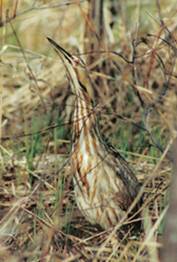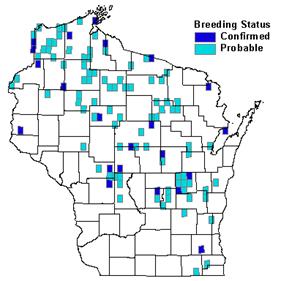Photo by Travis Mahan


Status/Protection
- Global Rank: G4 Key to global and state ranks
- State Rank: S3B
- WBCI Priority: SGCN, WBIRD, State Special Concern
Population Information
The Federal BBS information can be obtained at http://www.mbr-pwrc.usgs.gov/bbs/bbs.html by clicking on Trend Estimates and selecting the species in question. All estimates are for time period (1966-2005).
- Federal Breeding Bird Survey: non-significant decline
- Federal Breeding Bird Survey (WI): significant decline
- Federal Breeding Bird Survey (BCR 23): N/A
- Federal Breeding Bird Survey (BCR 12): non-significant decline
- WSO Checklist Project: significant decline (1983-2007)
Life History
- Breeding Range: British Columbia east across Canada and the northern U.S. to the Atlantic Coast (Gibbs et al. 1992).
- Breeding Habitat: Alder Thicket, Shrub-Carr, Northern Sedge Meadow and Marsh, Southern Sedge Meadow and Marsh, Open Bog-Muskeg, Emergent Marsh.
- Nest: Platform of emergent vegetation built over water (Gibbs et al. 1992).
- Nesting Dates: Eggs: mid-May to mid-July (Robbins 1991).
- Foraging: Stalk and strike, ground glean (Ehrlich et al. 1988).
- Migrant Status: Long-distance migrant.
- Habitat use during Migration: Similar to breeding habitat.
- Arrival Dates: Mid-April to mid-May (Robbins 1991).
- Departure Dates: Early September to early November (Robbins 1991).
- Winter Range: Coastal marshes from Virginia, N. Carolina west to California and Washington. Also found as far south as the West Indies, Costa Rica, and Panama (Gibbs et al. 1992).
- Winter Habitat: Wetlands, coastal marshes, grasslands where temperatures stay above freezing (Gibbs et al. 1992).
Habitat Selection
Across its range the American Bittern appears to use a wide variety of shallow emergent marshes and wetlands, and is known to nest in idle grasslands adjacent to wetlands. Robbins (1991) lists the habitat utilized in Wisconsin as wooded swamp, shallow marsh, and sedge meadow. In comparison to the sympatric Least Bittern, the American Bittern uses a wider variety of wetland cover types, less densely vegetated sites, shallower water depths, and exclusively freshwater habitats (Gibbs et al. 1992). The average wetland size for American Bitterns nesting in northern Minnesota was 36.7 ha (Hanowski and Niemi 1986), and similar results from other Midwestern states suggests that American Bitterns select for larger patches of appropriate habitat (Dechant et al. 2001). American Bitterns presumably use similar habitats in migration to those used for breeding.
Habitat Availability
In the early 1900s, ornithologists reported that the American Bittern was found in all suitable localities throughout Wisconsin, but were most numerous in the southern third of the state. Today, this pattern is reversed; the American Bittern is a more common summer resident in northern and central Wisconsin and an uncommon breeder in the southern parts of the state (Gostomski 2006). The largest concentrations of bitterns are found at large, publicly owned wetland/waterfowl complexes such as Crex Meadows or Horicon Marsh. Different local, state, federal, and non-governmental agencies are purchasing and managing wetlands for waterfowl and other wetland species. Many of these areas contain populations of American Bitterns, but it is not known if these areas are sufficient to sustain bittern populations statewide. As bittern populations shift northward, complexes such as Thunder Lake Wildlife Area or Powell Marsh may become more important. Many bitterns also were documented through the Wisconsin Breeding Bird Atlas in scattered wetland complexes across the northern half of the state but more work is needed to assess the importance of these sites.
Population Concerns
Few population data exist for this secretive wetland species. The American Bittern is detected on very few routes of the Breeding Bird Survey (BBS) but these data seem to indicate population declines range-wide and in Wisconsin (Sauer et al. 2005). Systematic, walk-through searches and counts of nesting and migrant American Bitterns are needed to better document population trends (Hands et al. 1989). The overwhelming threat to American Bittern populations both locally and nationwide is loss of wetland habitat. Over half the original wetlands in the coterminous U.S. have been destroyed. Inland freshwater wetlands, the most important nesting and wintering areas of American Bitterns, are among the most threatened habitats (Gibbs et al. 1992). In agricultural areas, chemical and agricultural runoff also may degrade habitat and impact prey populations. More work is needed on wintering grounds to assess potential threats.
Recommended Management
Wetland protection, both from development and degradation, is of primary importance in managing this species. This can be done through conservation easements, land purchases, tax incentives, management agreements, continuation of the Wetland Reserve Program, and enforcement of wetland-protection regulations. On existing public wetland properties, managers are encouraged to maintain a complex of wetlands of sufficient size (wetlands 20-30 ha in size up to 180 ha) to provide habitats at various stages of succession. Maintain water levels at <61 cm throughout the breeding season (April-August) and avoid complete drawdowns before mid-August on at least some portions of the wetland. During molting, bitterns need relatively deep, stable waters to provide adequate food and protection from predators. Use slow drawdowns to mimic natural wetland succession (Dechant et al. 2001). Conservation and management strategies for this species should be focused in the following Wisconsin ecological landscapes: Central Sand Hills, Central Sand Plains, Forest Transition, North Central Forest, Northwest Lowlands, Northwest Sands, Southeast Glacial Plains, and Superior Coastal Plain (WDNR 2005).
Research Needs
Annual population surveys at selected sites would elucidate the status of American Bittern and other wetland birds, such as Least Bittern and Black Tern (Hands et al. 1989). A standardized monitoring system for wetland birds as well as available wetland habitat is needed to better assess impacts of land use changes. Mitigated wetlands also should be monitored in order to assess their conservation value. Remarkably little is known about the biology of this species (Gibbs et al. 1992). Studies designed to answer questions about home range, dispersal, diet, mating systems, and habitat requirements are all vital to future conservation efforts.
Information Sources
- Cornell Lab of Ornithology species account: http://www.birds.cornell.edu/AllAboutBirds/BirdGuide/American_Bittern.html
- Dechant, J. A., M. L. Sondreal, D. H. Johnson, L. D. Igl, C. M. Goldade, A. L.Zimmerman, and B. R. Euliss. 2001. Effects of management practices on grassland birds: American Bittern. Northern Prairie Wildlife Research Center, Jamestown, ND. Northern Prairie Wildlife Research Center Home Page. http://www.npwrc.usgs.gov/resource/literatr/grasbird/ambi/ambi.htm
- North American Breeding Bird Survey http://www.npwrc.usgs.gov
- Wisconsin Breeding Bird Atlas http://www.uwgb.edu/birds/wbba/
References
- Dechant, J. A., M. L. Sondreal, D. H. Johnson, L. D. Igl, C. M. Goldade, A. L.Zimmerman, and B. R. Euliss. 2001. Effects of management practices on grassland birds: American Bittern. Northern Prairie Wildlife Research Center, Jamestown, ND. Northern Prairie Wildlife Research Center Home Page. http://www.npwrc.usgs.gov/resource/literatr/grasbird/ambi/ambi.htm
- Gibbs, J.P., S. Melvin, and F.A. Reid. 1992. American Bittern. In The Birds of North America, No. 18 (A. Poole, P. Stettenheim, and F. Gill, Eds.). Philadelphia: The Academy of Natural Sciences; Washington, DC: The American Ornithologists’ Union.
- Gostomski, T. 2006. American Bittern. In Atlas of the Breeding Birds of Wisconsin. (N.J. Cutright, B.R. Harriman, and R.W. Howe, eds.). The Wisconsin Society for Ornithology, Inc. 602pp.
- Hands, H.M., R.D. Drobney, and M.R. Ryan. 1989. Status of the American Bittern in the northcentral United States. Missouri Cooperative Fish and Wildlife Research Unit. University of Missouri, Columbia, MO. 13pp.
- Hanowski, J. M. and G. J. Niemi. 1986. Habitat characteristics for bird species of special concern. Unpublished report to Minnesota Department of Natural Resources, St. Paul, Minnesota. 50 pages.
- Sauer, J. R., J. E. Hines, and J. Fallon. 2005. The North American Breeding Bird Survey, Results and Analysis 1966 - 2004. Version 2005.2. USGS Patuxent Wildlife Research Center, Laurel, MD.
- Wisconsin Department of Natural Resources (WDNR). 2005. Wisconsin’s Strategy for Wildlife Species of Greatest Conservation Need. Madison, WI. http://devlwww.dnr.state.wi.us/org/land/er/wwap/explore/.
Contact Information
- Compiler: Andy Pauilos, Andy_Paulios@Wisconsin.gov
- Editor: Kim Kreitinger, K.Kreitinger@gmail.com
